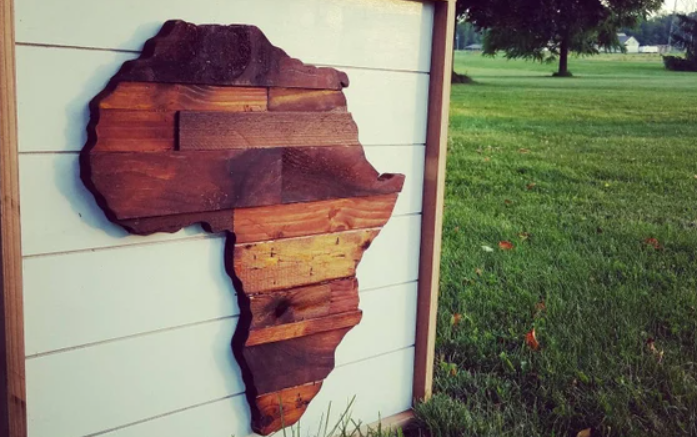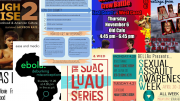The following is an editorial from an IMSA alumnus. This letter has been reviewed only for clarity and the appropriateness of its language, and no edits have been made to its content, claims, or assertions. The Acronym supports respectful discourse about the challenges facing our community and welcomes comments on this article which uphold that standard.
Submitted by: Emily Margaret Nakiganda ’22
The first time I recognized our society’s perception of Africa, I was in first grade. As I sat at my desk coloring, one of my classmates tapped me on the shoulder. I turned to face him and he handed me a picture he’d drawn of a caveman wearing lion skin and holding a spear. With curious eyes, he asked me, “That’s what it’s like in Africa, right?” I didn’t know what to say. I was upset, but not out of anger at the boy. No, at seven years old, I was upset because I knew that the issue didn’t lie with him. It lay with what he had and hadn’t been taught.
Lying in bed that night, I wished that my classmates and I would get to learn about Africa in our classrooms together. That as we got older, our school system would finally represent the Africa I knew. The continent with thousands of different cultures and languages. The one with complex political issues. The Africa that was more than a Western narrative of slavery, poverty, and famine. That was ten years ago, and it makes me sick to my stomach to know that my wish never came true.
No education ever came, and as a result, my African peers and I were faced with regular microaggressions due to our culture. In my own experience, misinformation pushed my fellow elementary students to tell me I was only fast on the playground because my “African bones” made me an anatomical other among them. It contributed to the preconceived notion that my family had immigrated out of extreme poverty, and the infuriating daily instruction to us to finish our lunches, “because people in Africa would kill for the scraps on our plates.” On the very rare occasion Africa was mentioned in my classrooms, its brief cameo in the curriculum would start with slavery and end with colonialism, as if Africa’s significance started and ended with its relationship with its Western oppressors. As if the thousands of cultures within Africa’s borders had a singular narrative. All in all, the lack of education surrounding Africa created a breeding ground for misinformation among my peers. By my freshman year of high school, I was beyond fed up with the broken-record, poverty-slave narrative my school system had fed my classmates and I about Africa. I was determined to get my African education, so I applied to IMSA.
IMSA flaunted its multicultural education. Effectively using its culture shows as a selling point, it promised to be a sanctuary, the kind of space where my peers and I could finally experience nuanced lessons on Africa and other regions seamlessly integrated into our curriculum. From the second I moved in to the last day of my sophomore year, I waited for it to happen. After realizing it wasn’t coming, my friend Temi Ijesesan and I decided to teach IMSA about Africa ourselves.
We spent the entire summer planning the creation of an African Student Association (ASA), a staple at most colleges. We imagined that, together, we would expose the student body to all of the multifaceted narratives from Africa we’d waited to hear in our classes. We’d teach them about African history, modern politics, and cultures. We intended to allow anyone to get involved by extending open membership, all the while fostering unity between students with African identities. In preparation for the year, we contacted ASA presidents at different universities. We planned political discussions, cooking events, fashion shows, Nollywood movie nights, and even a troupe of Ugandan dancers to grace our halls. We were going to give every student at IMSA the opportunity to get involved in African culture and show them the side of Africa our education system refused to teach.
We were promptly denied charter. The Student Council believed that an African Student Association would be too similar to the Black Student Union (BSU), and that it would be redundant on campus. It didn’t matter how many times on our club charter we explained ASA and BSU’s completely unrelated focuses and goals, or how many times we had to spell out that black and African aren’t synonymous. After facing an initial rejection, we decided to fight, and we were subjected to an appeal process unlike any other.
The two of us were put through seven different meetings with members of IMSA’s administration and BSU, in which we had to justify why African education and representation deserved to be a priority at all to people who had no role in the club charter process and hadn’t even read our application. For two sophomores trying to stand up for our identities, the meetings were incredibly emotionally taxing. At one meeting, an executive BSU board member unintelligibly screamed at us after another member accused us of founding the club to spite BSU after we’d been denied roles as representatives earlier in our sophomore year.
As bad as our peers’ behavior was, IMSA administration’s was indubitably worse. The adults we’d thought were our advocates not only watched as we were attacked by our peers, but they actively expressed their doubts in our own experiences. In one meeting, after sharing our experiences with misinformation and the lack of African education in our academic careers, an Equity and Inclusion Program Development Associate insisted over and over again that the yearly Soul of the Motherland event and five minute African Harambee dance meant that we were actually fully represented at IMSA but that we just didn’t realize it.
After 1–2 hours of emotionally exhausting meetings every week, we were finally granted a final, official appeal meeting, a courtesy every club denied charter receives. In these appeal meetings, the club leaders get to address all of the issues Student Council had with their charter before receiving a final decision later. I know because I’ve conducted them myself. Ours was different. After hours of preparation for the meeting, we arrived at the Zoom call to find that we wouldn’t have the chance to advocate for ourselves at all. In fact, within the first two minutes, before allowing us the chance to speak, Andrea Stuiber informed us that ASA would not be chartered that year, no matter what we said in the rest of the meeting. The most formative memory I had in my sophomore year was crying over the phone with Temi after that meeting, thinking that we had both failed our continent.
A year later, long after our ASA dream had been forcefully crushed, Temi and I both opted to take IMSA’s Global History of Africa class. As seniors, it would be the first and last opportunity we’d have to investigate Africa in our entire academic careers. The class was unceremoniously canceled a week before the school year began, which led to the most frustrating experience I’ve ever had with IMSA’s administration to date.
After voicing my frustrations about the lack of African representation in academia, I was approached by a group of students. They’d formed an independent Global History of Africa study group that met each week with the prospective teacher, Dr. Sheila Wille. Together, the group gathered to read and discuss excerpts of academic texts on Africa, and they invited me to join. While completely extracurricular, the opportunity allowed me to take a deep dive into some of the nuances of relatively recent African history. We learned how medical practices differed between East and West Africa in the twentieth century. We discussed the importance of community structures in different African societies. We even investigated the role of spirituality and religion in colonialism. And, at the start of the second semester, the study group came up with an idea.
To share the important lessons we’d learned over the year with the IMSA community, we planned a final project. The first aspect of the project was an educational art installation we’d gotten permission from a faculty member to hang in the hallway between the main building and A-wing. After consulting Grant Bell in IN2, we settled on a wooden laser-cut board displaying all of the different ethnic groups in Africa, as well as an overlay of the borders that colonial powers drew to divide them. We also planned to create an African informational database where we, and future students, could submit papers to, supplementing the Global History of Africa course the next time it came around. Finally, we’d outline a path for the creation of an SIR that would allow students to investigate Africa on their own time. The estimated grand total for this venture? $295.16.
We sent the proposal to IMSA’s President, Dr. Evan Glazer, on February 27, who told us to submit an Innovation Grant proposal for funding. We did and waited for a response. And waited. And waited. We emailed three separate times to learn when decisions would come out. The first time, the President told us it’d be April 14, which would give us plenty of time to complete our project. Once April 14 had come and gone, we were told it would be April 22. The 22nd arrived, and still no answer. On April 26, we received our decision.
The entirety of the email is copied here: “Thank you for applying for the IMSA Undesignated Innovation Grant. Unfortunately, your proposal, “Art Installation accompanied by research that introduces IMSA to the cultural, ethnic, and linguistic complexities of Africa in the past and present”, was not funded for the following reason: Considering our Academic priorities, specifically the work we have been focusing on around looking at curriculum, instruction and assessment (including practices and processes) through a lens of equity, this is more of an expectation rather than an innovation. Please contact Dr. Akwaji-Anderson and Dr. Robert Hernandez if you have any questions.”
I agreed. I considered African representation an expectation as well, one IMSA was falling miles short of. We emailed the principal that day for a clearer explanation. She never responded. Months had passed since we’d initially planned to start working and we were running out of time. We went to Dr. Glazer’s office. His secretary denied our meeting until we’d met with Dr. Jeanette Bartley, the Dean of Academics and Equity. We met with her the next day, and she understood the importance of our project and the issue at hand. She emailed Dr. Adrienne Coleman and Dr. Comfort Akwaji-Anderson, explaining how time-sensitive the issue was. We set up a meeting with Dr. Coleman soon after.
She told us that DEI would fund the project, but when we discussed the Africa-sized hole in IMSA’s curriculum, she commented that we couldn’t ask teachers to talk about Africa in their existing classes because each teacher had a specialty and we couldn’t expect them to go out of their way to research Africa to teach us. I wondered, “Isn’t learning about Africa a baseline expectation in its own right?”, but persevered with the project. A week later, Dr. Coleman informed us that DEI couldn’t fund the project after all, at least not that year. At that point, it was May 12 and time wasn’t on our side. We had no choice but to turn back to the Principal’s Office. After asking Dr. Akwaji-Anderson in person in the hallway, she explained that our Innovation Grant proposal was denied because our project wasn’t considered an innovation. She then asked us to set up a meeting with her so we could present a revised version. We set one up with her secretary for May 13 at 12:00 PM.
On May 13 at 12:00 PM, we showed up to her office. She told us that she was busy during the time slot we’d already scheduled with her, and that we needed to set up another meeting with her secretary. We did. The next meeting was scheduled for May 20 at 10:30 AM. On May 20 at 10:30 AM, our group was surprised to find the entire Principal’s Office locked. Through the office’s open blinds, the principal could still be seen sitting at her desk, and a group member made eye contact with her. That member found Mr. Paul Gaszak, who took it upon himself to call the principal on our behalf to remind her that she had a meeting officially scheduled with us during that time. Without addressing the group member at all, she told Mr. Gaszak that she was busy for the entirety of the twenty minutes we’d scheduled with her the week before, and that we needed to set up another meeting. I came back an hour later once the Principal’s Office was unlocked and waited until I could speak to her. After canceling two meetings after the fact without even letting us know, she told me for the third time that she was simply busy, and we needed to set up another meeting with her secretary. That day, I learned that it didn’t matter how determined we were, so long as our administration was so intent on turning us away.
And at the start of June, I was set to graduate without fulfilling the primary goal I had come into IMSA with. Two days before graduation, the IMSA Black Alumni Association donned each black graduate with a beautiful kente stole embroidered with the Pan-African flag. Although the stoles were reminiscent of the black and African graduation stoles students across the country wear to celebrate their heritage and achievement, we were banned from wearing them to our own graduation. After asking him directly why we were forbidden from wearing them, Dr. Glazer looked me in the eyes and told me it was because he wanted us to be uniform. Instead, he extended the courtesy of allowing us to wear it where no one could see, under our gowns.
After spending three years begging the brick wall that is IMSA’s administration for the mere opportunity to educate our school on African cultures, the sharpest slap in the face was delivering my class’ graduation speech with my kente cloth invisible, buried under my gown. Months removed, I still can’t shake the feeling that the heritage that was so imperative to my accomplishment was buried too, effectively invisible.
My time is up. As an alumni, a past student, I cannot continue my fight within IMSA’s walls. Instead, I wrote this to tell IMSA’s present and future students what my three years taught me. Your school doesn’t care if you graduate ignorant and misinformed about the most diverse continent in the world. IMSA doesn’t care if its students aren’t represented, and it certainly won’t let you try to represent yourselves. New classes don’t get funded, new clubs are rejected, proposals to add lessons onto the existing curriculum are met with vague excuses, and one-off projects are steadily denied. Don’t wait for permission to take action like I did, because chances are it’ll never come. Whether your cause is Africa or India or South America, hold your school accountable. A dream deferred is a dream denied. Don’t let it happen to you too.






I witnessed the frustrating experience Temi Ijisesan and Emily Nakiganda had in trying to charter ASA at IMSA and it was painful to watch. I felt it did not have to be so difficult to bring a club that would enrich the student community at IMSA in rich African culture to the school. I also felt the two ladies who were trying to bring something positive to the school were treated unfairly. The school could have done a better job of supporting them in the process. Emily has done a great job of chronicling the experience in this article.
“IMSA flaunted its multicultural education. Effectively using its culture shows as a selling point, it promised to be a sanctuary…”
This is especially frustrating to read after finding out this school year’s culture shows would be merged together. After a year of these shows being shoved into the gymnasium, you’d think the transition back into the auditorium would be a big step in the right direction. Props to current IMSA students for making the most of what the school could provide.
But this is about more than culture show funding.
Limiting the education of culture to the scope of PME’s authority (which past members can agree is getting weaker and weaker, if not already insignificant) waters down the topic of culture. It’s become a competition of board positions for college applications. A desperate attempt to prove the “worth” of simply celebrating your identity. This is humiliating. It’s not right to just leave it to the students to scavenge for whatever resources they can get. Multicultural education seriously needs more support from higher-ups.
As Emily’s article points out, there are so many opportunities to prove IMSA’s administration actually cares: classes, SIRs, SERIOUS discussions and meetings… yet time and time again, students who want change are let down. Why is that? Why aren’t we getting real answers?